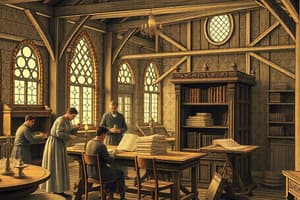Podcast
Questions and Answers
What was the role of Johannes Gutenberg in the history of printing?
What was the role of Johannes Gutenberg in the history of printing?
- He produced the first handwritten Bible.
- He established the first printing workshop in London.
- He invented the printing press in Paris.
- He introduced movable type printing machines in Mainz. (correct)
How did the spread of printing presses impact access to information?
How did the spread of printing presses impact access to information?
- It increased accessibility to local language books. (correct)
- It made Latin texts more exclusive.
- It limited the availability of religious texts.
- It reduced competition among printers.
What technological innovation revolutionized publishing in Europe during the Renaissance?
What technological innovation revolutionized publishing in Europe during the Renaissance?
- Woodcut printing
- Movable type printing machines (correct)
- Lithography
- Handwritten manuscripts
Which social groups benefitted from the surge in literacy due to printed materials?
Which social groups benefitted from the surge in literacy due to printed materials?
What was one common type of printed material that became widely accessible with the spread of printing presses?
What was one common type of printed material that became widely accessible with the spread of printing presses?
Which aspect of book design saw advancements in typography, illustrations, and text layout during the Renaissance printing era?
Which aspect of book design saw advancements in typography, illustrations, and text layout during the Renaissance printing era?
What was a significant innovation in printing methods during the Renaissance period?
What was a significant innovation in printing methods during the Renaissance period?
Which of the following works reshaped global perceptions of geography, history, philosophy, and natural sciences during the Renaissance printing era?
Which of the following works reshaped global perceptions of geography, history, philosophy, and natural sciences during the Renaissance printing era?
Which city was not a prominent hub for printing activities during the Renaissance period?
Which city was not a prominent hub for printing activities during the Renaissance period?
What did the bustling publishing houses of the late medieval and early modern periods signify in European history?
What did the bustling publishing houses of the late medieval and early modern periods signify in European history?
Flashcards are hidden until you start studying
Study Notes
Printing in European History: A Journey Through Time with Renaissance Ink
The story of printing in Europe begins during the tumultuous era of renaissance—an epoch known for its artistic, intellectual, and scientific revolutions. As we delve into this captivating chapter of history, let's unravel how the medium of print flourished throughout medieval and early modern Europe.
Birth of Modern Printing in Mainz
In the year 1450, Johannes Gutenberg, a German goldsmith turned printer, introduced movable type printing machines using metal letters created from molten lead. This technological marvel revolutionized publishing and knowledge dissemination across Europe. By the end of his lifetime, approximately 180 Bible editions were printed by Gutenberg's presses, providing the foundation for what is now known as the first mass-produced book.
Spread of New Ideas through Presses
As the technique gained traction in Germany and beyond, printers rapidly established their own workshops, increasing competition yet further enhancing innovation. Newsletters, pamphlets, religious texts such as the Biblia Pauperum, and books written in local vernacular languages became widely accessible, allowing readers to access information previously limited to Latin texts.
Impact on Society and Economy
This surge in literacy strengthened social movements within medieval communities. Artisans, merchants, and people from all walks of life expanded their horizons via printed materials. Additionally, economic growth ensued due to increased demand for books, leading to prosperous trade networks that facilitated communication among various cultural centers.
Rise of Publishing Hubs
Several cities throughout Europe emerged as prominent hubs for printing activities. Notably, Basel, Strasbourg, Venice, Lyon, Paris, and Nuremberg hosted numerous renowned publishers who contributed significantly to enriching European culture. These vibrant publishing environments fostered collaboration between writers, scholars, artists, and engravers, propelling advancements in typography, illustrations, and text layout—essential aspects of modern book design.
Cultural Transformations
Throughout the 17th century, printing technologies progressively evolved alongside art and science disciplines, resulting in striking innovations like indigo ink, stereotyping, and lithographic printing methods. Furthermore, this period witnessed the rise of encyclopedias, maps, and other reference works that reshaped global perceptions of geography, history, philosophy, and natural sciences.
Printing in European history represents more than just advances in technology; it embodies collective aspirations towards exploration, elaboration, and exchange of ideas. From Johannes Gutenberg's modest workshop in Mainz to the bustling publishing houses of the late medieval and early modern periods, this remarkable journey has left an indelible imprint upon our world and continues to shape the course of human civilization.
Studying That Suits You
Use AI to generate personalized quizzes and flashcards to suit your learning preferences.




